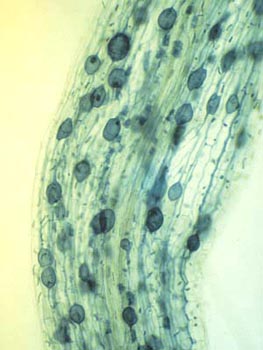Endomycorrhizal fungi: Difference between revisions
| Line 7: | Line 7: | ||
==Function of Endomycorrhizal fungi== | ==Function of Endomycorrhizal fungi== | ||
Endomycorrhizae have several functions, the major one being nutrient acquisition. Endomycorrhizae facilitate the exchange of nutrients between the host plant and the soil. Mycorrhizae aid in the uptake of water, inorganic phosphorus, mineral or organic nitrogen, and amino acids. In exchange for the mycorrhizae providing all of these nutrients, the plant in turn provides the mycorrhizae with carbon. This relationship benefits both organisms immensely. The mycorrhizae greatly increase the surface area of the plant’s root system which is hugely beneficial in areas where drought is common. This is also beneficial in areas where the soil is nutrient-poor. The larger surface area gives those plants an advantage over plants lacking this symbiotic relationship allowing plants with mycorrhizal relationships to out-compete for nutrients. Mycorrhizae also offer the roots of the plant a little more protection. <br><br> | |||
==Section 2== | ==Section 2== | ||
Revision as of 02:16, 8 November 2013
Introduction
Endomycorrhizal fungi (more commonly referred to as endomycorrhizae) is one of the major types of known mycorrhizae which differs from the another type of mycorrhizae, ectomycorrhizae, in structure. Unlike ectomycorrhizae which form a system of hyphae that grow around the cells of the root, the hyphae of the endomycorrhizae not only grow inside the root of the plant but penetrate the root cell walls and become enclosed in the cell membrane as well. This makes for a more invasive symbiotic relationship between the fungi and the plant. The penetrating hyphae create a greater contact surface area between the hyphae of the fungi and the plant. This heightened contact facilitates a greater transfer of nutrients between the two. Endomycorrhizae have further been classified into five major groups: arbuscular, ericoid, arbutoid, monotropoid, and orchid mycorrhizas.

Function of Endomycorrhizal fungi
Endomycorrhizae have several functions, the major one being nutrient acquisition. Endomycorrhizae facilitate the exchange of nutrients between the host plant and the soil. Mycorrhizae aid in the uptake of water, inorganic phosphorus, mineral or organic nitrogen, and amino acids. In exchange for the mycorrhizae providing all of these nutrients, the plant in turn provides the mycorrhizae with carbon. This relationship benefits both organisms immensely. The mycorrhizae greatly increase the surface area of the plant’s root system which is hugely beneficial in areas where drought is common. This is also beneficial in areas where the soil is nutrient-poor. The larger surface area gives those plants an advantage over plants lacking this symbiotic relationship allowing plants with mycorrhizal relationships to out-compete for nutrients. Mycorrhizae also offer the roots of the plant a little more protection.
Section 2
Include some current research, with a second image.
Conclusion
Overall text length should be at least 1,000 words (before counting references), with at least 2 images. Include at least 5 references under Reference section.
References
Edited by [Author Name], student of Joan Slonczewski for BIOL 116 Information in Living Systems, 2013, Kenyon College.
